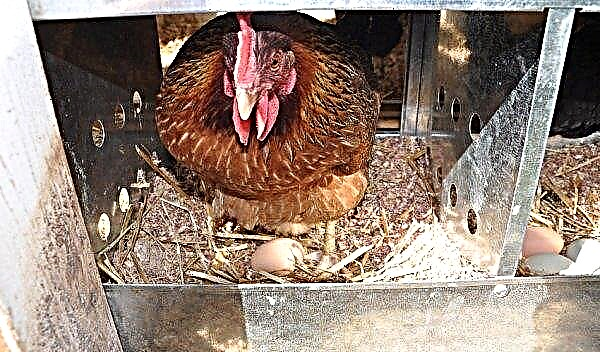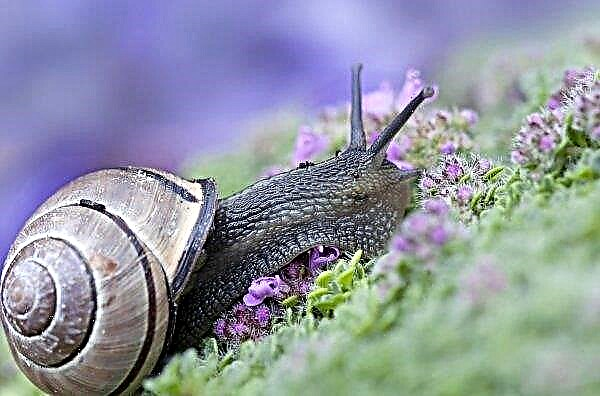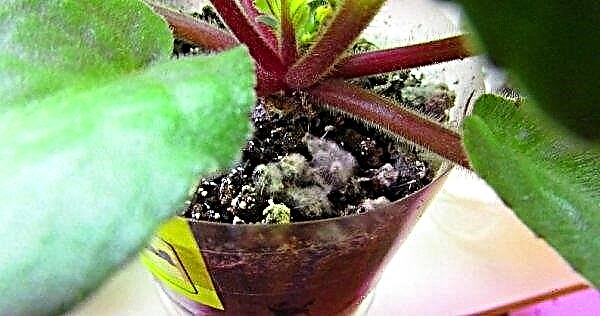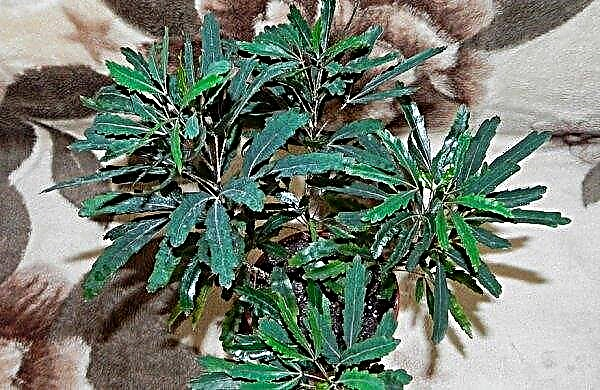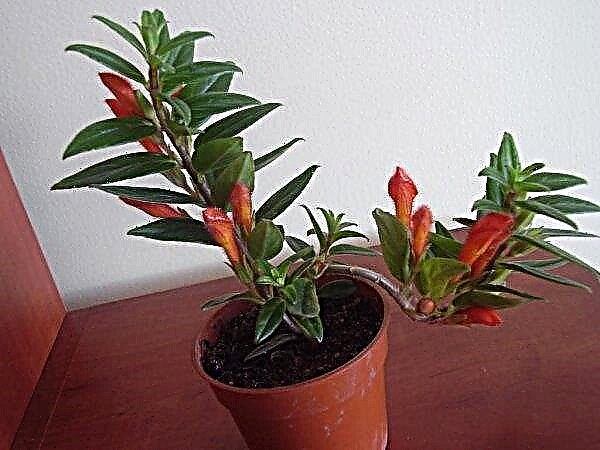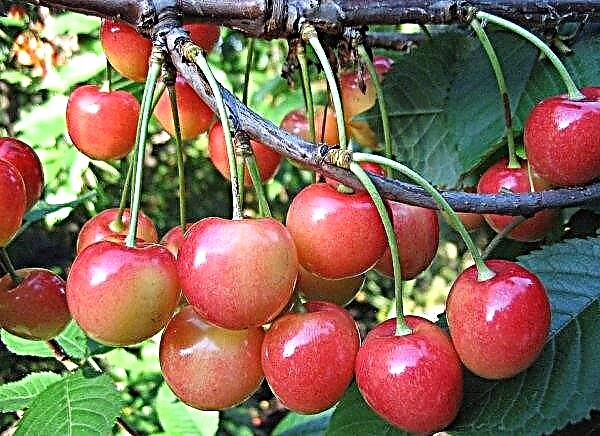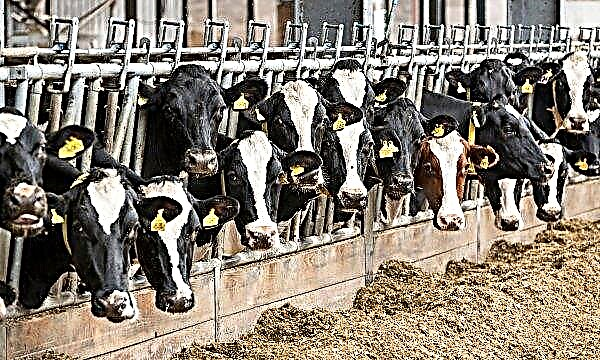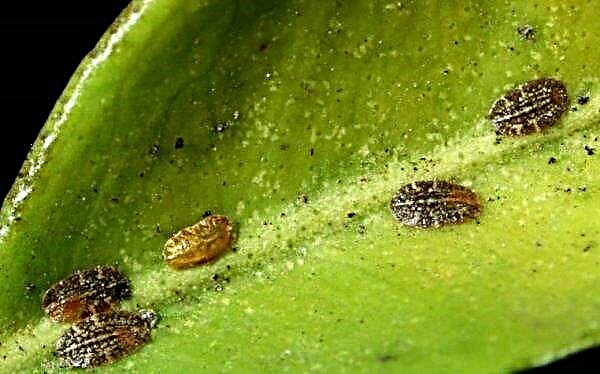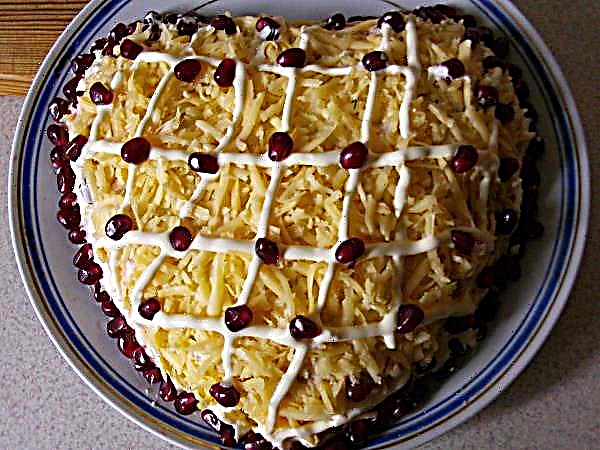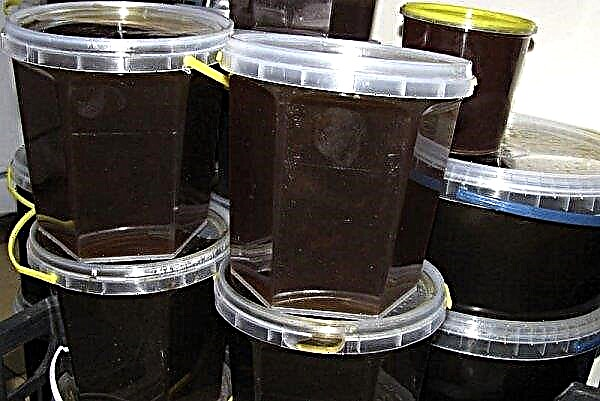Good productivity, strong immunity, longevity, unpretentiousness in the conditions of maintenance and care are the main features of the Scottish Highland cows. Thanks to nutritious meat and dairy products, which taste like game, it is known far beyond Europe. And in some countries, these long-haired animals with a specific exterior are positioned along with other exotic fauna representatives in zoos. What is special about Highland cows, what place they occupy in the world cattle breeding, in what conditions they will be comfortable, and whether there are ways to increase the efficiency of their breeding - you will learn about all this later in the article.
Breed description
Highlands are one of Scotland's oldest cows. Local pastoralists bred this breed from Celtic native cattle, which was distinguished by its large size, unpretentiousness and a high degree of adaptation to harsh climates. In the process of breeding, only the best characteristics of the parent livestock were taken into account. As a result, the young growth was distinguished by long curly hair, massive horns, and a very elongated fringe. This pretty non-standard exterior is preserved even after many years of improvement of the breed. Only the dimensions of the cows are lost. Today they are decorative miniatures of cattle, but, despite this, they are characterized by satisfactory productivity.
As a result, the young growth was distinguished by long curly hair, massive horns, and a very elongated fringe. This pretty non-standard exterior is preserved even after many years of improvement of the breed. Only the dimensions of the cows are lost. Today they are decorative miniatures of cattle, but, despite this, they are characterized by satisfactory productivity.
It is not difficult to recognize the highlands among thousands of relatives. According to the breed standard, they are characterized by:Did you know? Queen Elizabeth II of Great Britain is also a fan of Highlands. A herd of hundreds of these cows lives in her summer residence Balmoral, located in Scotland on the banks of the River Dee.
| External signs of the Scottish Highland cow breed | |
| Horns | Long, pointed, curved |
| Head | Proportional to the body size, with a short muzzle and strong jaws |
| Eyes | Large, wide-set |
| Neck | Straight long with a pronounced crest in males |
| Chest | Deep, moderately wide |
| Dewlap | Missing |
| Housing | It is characterized by arched ribs and an oval back. |
| Musculature | Well developed |
| Skeleton | Strong |
| Limbs | Powerful, short but steady |
| Wool | Outer, long (up to 30 cm), wavy or straight |
| Undercoat | Lush |
| Suit | Yellow, Bulan, red, black, spotted exotics are occasionally found |
| Height at withers in adults | 110-130 cm |
| Average weight | 450 ֫ –670 kg |
Thanks to these characteristics, Scottish mini-cows can withstand the conditions of a cold climate and overcome long distances in the mountains. These alpine cows are also able to withstand predators. But cattle farms are of great interest not for the decorative characteristics of animals, but for their productivity. Experts attribute this variety to the meat type, since the maximum daily milk yield from highlands does not exceed 5 liters. Therefore, their breeding in order to obtain dairy products against the background of more productive species loses its relevance. For more information on breed productivity, see the table below:
Experts attribute this variety to the meat type, since the maximum daily milk yield from highlands does not exceed 5 liters. Therefore, their breeding in order to obtain dairy products against the background of more productive species loses its relevance. For more information on breed productivity, see the table below:
Did you know? The most expensive cow meat in the world is a marble product obtained from the Japanese breed of wagu. These unique animals live near the town of Kobe and have a very selective diet. Owners for their horned wards select the best feed, carefully monitor their quality, and periodically treat horned beer with beer and wipe their skin sake.
Pros and cons of breeding
Today, Scottish cows are popular in North America, European and Asian countries. Farmers appreciated the unpretentiousness of shaggy cows, but also noted the shortcomings in their content.
- pros
- animals easily adapt to severe weather conditions;
- undemanding to a nutritious diet;
- hardy;
- possess strong immunity, which is laid down at the genetic level (cows are resistant to common infectious and colds);
- for maintenance it is enough to get a corral and canopy;
- long life and excellent preservation of productive qualities (up to 20 years of age);
- good survival of the young generation with minimal human involvement;
- friendliness and peaceful disposition (with the exception of females that protect their offspring);
- engaged in an independent search for feed, animals contribute to the utilitarian restoration of pastures;
- well-developed maternal instinct in females;
- satisfactory quality of beef.
- Minuses
- low milk productivity;
- low weight gains, which prevents intensive methods of breeding;
- extensive pasture grazing is required;
- inability to maintain in the southern and intercontinental climatic zones;
- late ripening.
Important! To increase the productivity of the Scottish Highlands should be kept herd in the open.
Content Features
It is the unpretentiousness of this highly productive breed that plays a key role for many farmers in choosing cows for their farm. Indeed, in fact, with minimal involvement of the human resource, one can obtain high herd productivity indicators. What are the main tasks of the breeder, we will consider further in detail.
Summer walking area
"Scotch" are self-sufficient animals that can well provide themselves with pasture, as well as warm themselves in inclement weather. They do not require a leash and feel comfortable with year-round grazing. However, the owner must take care that his wards have the opportunity to hide from rain, dampness and sunshine. For these purposes, it is recommended to build small, non-insulated shelters on the pasture.
Arrangement of a barn
Despite the stability of the “tartan” before cold and frost, they will still be more comfortable spending the night in a cozy barn. Therefore, the farmer should take care of the dryness and cleanliness of the room. It is desirable to place it on a hill away from human habitation, as well as from water bodies, including wells and boreholes. A place protected from the north winds is ideal.
Building material for the barn is selected based on the climatic characteristics of a particular region. Environmentally friendly variations with good wear resistance and heat dissipation are preferred.
Important! The barn area should correspond to the size of the animals. It is calculated taking into account the space for feeding, rest and unhindered movement of wards. 6 sq. Meters is enough for one adult mini-cow. m
Indoors, you should definitely provide feeders and drinking bowls, as well as hay nurseries. Please note that containers for dry and wet feed must be different. Most often these are hinged plastic vessels with a length of up to 120 cm, a width of up to 40 cm and a height of up to 75 cm. When choosing them, it is important to pay attention not only to the strength of the material, but also to the ease of installation. After all, every day you will need to clean the feeder from under the feed residue. It is better to make a sennik hinged from lattice details, but taking into account that the cow could stick its head between them. In addition, many owners during the construction of the stall equip a special gutter for runoff of manure. However, this option is suitable only if there is no litter. Otherwise, straw from boneless cereal crops is preferred. For highlands that have thick warm coat, its layer should be minimal.
In addition, many owners during the construction of the stall equip a special gutter for runoff of manure. However, this option is suitable only if there is no litter. Otherwise, straw from boneless cereal crops is preferred. For highlands that have thick warm coat, its layer should be minimal.
Separate feeding troughs and drinking bowls for Scottish cows will also be needed in the pasture. For this, experienced cattle breeders are advised to equip special feeding grounds on the territory. It is strictly forbidden to set haystacks just on the ground. With this approach, it is impossible to avoid the inappropriate consumption of feed, since animals will trample them into the ground each time.
Conditions of detention
A feature of this alpine long-haired breed of cows is their adaptability to different climatic zones. Most often, these exotics are found in cold regions, because they are characterized by genetic endurance to low temperatures, inclement weather, and also to various pathogenic microbes. That is why for the maintenance of such cattle, insulated or heated cowsheds are not required at all. In winter, animals can feel comfortable at temperatures from -3 ° C. Even wintering in the snow, the herd will not get sick. But the younger generation requires increased comfort. It is advisable to place a cow with a calf in a barn, where the thermometer reaches +10 ... + 15 ° С.
In winter, animals can feel comfortable at temperatures from -3 ° C. Even wintering in the snow, the herd will not get sick. But the younger generation requires increased comfort. It is advisable to place a cow with a calf in a barn, where the thermometer reaches +10 ... + 15 ° С.
Did you know? The Holland-Durham hybrid Mount Katadin, which weighed 2270 kg, is considered the world record cow in the weight category. At the same time, the height of the withers of the giant animal reached 1.88 m, and the chest girth - 3.96 m.
Highlands are very sensitive to heat. Because of the thick coat for keeping in warm countries, they are unsuitable. Nature protected them from discomfort in harsh living conditions. For example, a long bang, which often completely covers the muzzle, is needed by cows to protect their eyes from insects, snow, wind, and various infections.
If you plan to keep Scottish cows indoors, it is important to provide a lot of windows or equip it with good lighting. These animals are accustomed to the natural conditions of the wild, and therefore require minimal human intervention. It is unacceptable for the wards to be in a dirty barn with a suffocating odor of manure. Ammonia vapors from cow excrement adversely affect the productivity of animals, as well as their general condition. In this regard, the barn should be aired daily. To do this, when arranging it, it is important to build a high-quality ventilation system. In an extreme case, its function can be performed by windows and doors that are open during the day herd of the herd. However, you should not test the strength of livestock with drafts.
It is unacceptable for the wards to be in a dirty barn with a suffocating odor of manure. Ammonia vapors from cow excrement adversely affect the productivity of animals, as well as their general condition. In this regard, the barn should be aired daily. To do this, when arranging it, it is important to build a high-quality ventilation system. In an extreme case, its function can be performed by windows and doors that are open during the day herd of the herd. However, you should not test the strength of livestock with drafts.
Cleaning
The cleanliness of the shed where the cows are kept is the key to their high productivity, so it is advisable for the owner to immediately provide for a convenient cleaning system when arranging the premises. After all, you will need to remove manure daily. This approach will avoid unpleasant odor and aftertaste from milk, as well as irritation of the cow's udder, hooves. This is not an aesthetic issue, but a production necessity.
High-quality cleaning of the premises provides for the complete elimination of accumulations of animal vital products in the areas of the stall and feeding, including slit space, as well as the regular change of litter, which is carried out as necessary.
In addition to cleaning the flooring, the farmer needs to pay special attention to containers for feeding horned pets. After each feed intake, it is important to remove their residues, preventing souring and fermentation. The same goes for drinkers. Experienced cattle breeders are advised to calculate a single amount of water so that it does not stagnate, but that the animal has enough to quench thirst.
Did you know? Cows feel the Earth’s magnetic field and position their body while feeding and resting along its lines of force..
Feeding and drinking
Highlands do not require a special diet. They can fully function on pasture. Moreover, this breed compares favorably with the ability to eat hard vegetation, which is unsuitable for other breeds. How to usefully diversify the food menu of the wards and how much water they need, we will understand in more detail.
Livestock pasture and feeding in the summer
In the warm season, it is recommended to keep a herd of “tartan” on the street, equipping a special area for feeding and watering. Experienced breeders advise horned jaws before the onset of severe cold weather. For example, forbs serves as exotic grasses, as well as branches of shrubs and stunted trees.  In our latitudes, burenki prefer to use crops of alfalfa, clover, fescue, as well as arzhanets and perennial chaff. Due to the physiological characteristics of their structure, cows can digest juicy, rough and grain feeds.
In our latitudes, burenki prefer to use crops of alfalfa, clover, fescue, as well as arzhanets and perennial chaff. Due to the physiological characteristics of their structure, cows can digest juicy, rough and grain feeds.
Differences in winter feeding
In the cold season, horned pets require silage, hay, steamed straw, twigs from plants, as well as whole grain, meal and cake for a stable weight gain. Salt additives, bone and meat and bone meal, fish oil, wood ash, chalk, needles and urea will not interfere.
In agriculture, the winter diet of cows is characterized by a predominance of silage and concentrated feed. To provide animals with energy, special attention should be paid to the grain nutrition components:
- corn;
- barley;
- oats;
- wheat.
 And you can also add components such as:
And you can also add components such as:
- starch;
- potatoes;
- meal from soy and sunflowers;
- bran;
- beer and bread yeast.
Important! The taste of cow's milk is largely dependent on the feed consumed. For example, if an animal ate wormwood or colza, its dairy product will have an unpleasant bitter taste and smell..
Water
Regardless of how much milk the Scottish cows give, they need to be provided with enough drinking. For an animal, it has the same meaning as food.
According to experts, adults need to drink at least 100-150 liters of water per day. However, this amount is recommended to be divided into 10 receptions. Thus, a single serving corresponds to a 10-liter bucket. It should be borne in mind that this figure is determined by the type of feeding and the temperature regime of the herd.
Experienced cattle breeders note the increased addiction of cows to water before milking, as well as after feeding with concentrates. In large farms, special counters are installed for precise control of the drinking liquid. In addition, it is important to monitor the purity and quality of the water. After all, the high content of bacteria, nitrates, heavy metals and sulfates in it adversely affects the health of horned pets. In order for the watering to be most useful to the highlands, it is recommended to monitor the temperature of the drink. Optimum indicators - +16 ... + 17 ° С. It is also important to ensure that each cow has free access to drinking bowls.
In order for the watering to be most useful to the highlands, it is recommended to monitor the temperature of the drink. Optimum indicators - +16 ... + 17 ° С. It is also important to ensure that each cow has free access to drinking bowls.
Highland Scottish burenki deserve attention not only for their decorative appearance, but also for their simplicity. With minimal human effort, they are able to thank the breeder with quality meat products. A significant disadvantage of growing highlands is their low prevalence in the post-Soviet space and, accordingly, the high price.


